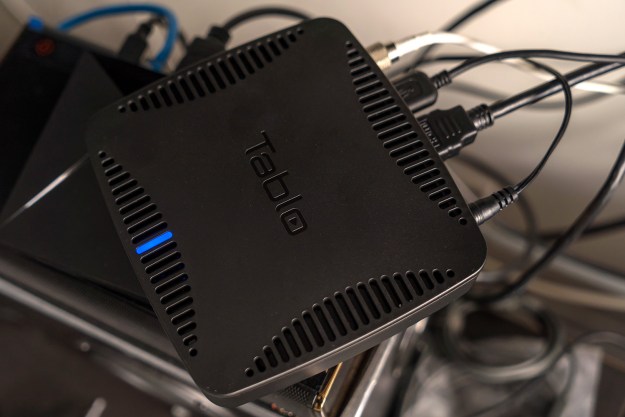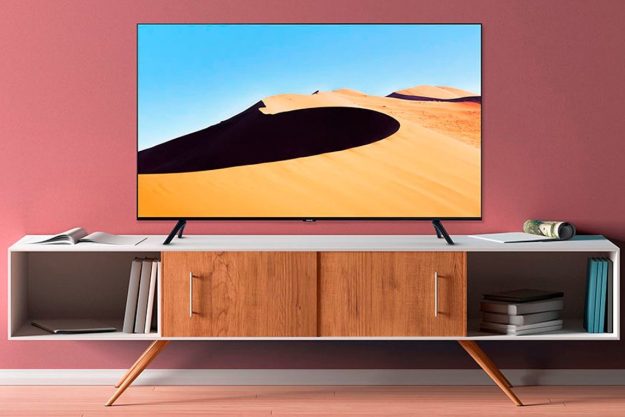
“A simple, straightforward OTA DVR solution.”
- HDMI for TV connection
- New remote control
- Easy setup
- Simple interface
- Local streaming to TVs and boxes
- No remote access
- No streaming to mobile apps and browsers
- No internal storage
For Nuvyyo, its Tablo devices have always represented an alternative to expensive cable packages, and the concept has always been an easy sell. Pull in free over-the-air TV channels and either watch them live or record them to watch later. Just stream them to compatible devices, and you’ve got plenty of content that doesn’t come with a fat monthly bill.
The new Tablo Dual HDMI OTA DVR sticks to the plan, yet deviates in execution, primarily by restricting where you can actually put it. Unlike other Tablo units, this box must be plugged into a TV. Everyone can appreciate a direct approach, but is this the right one for your cable TV freedom?
Editor’s note: Tablo released a fourth-generation device in late 2023. Be sure to check out our full fourth-generation Tablo review.
Out of the box
There’s not a whole lot to stare at when unboxing the Tablo Dual HDMI OTA DVR. What does stand out is the new remote control — a first for Nuvyyo. Beyond that, there’s the set-top box along with a power adapter, HDMI cable, Ethernet cable, and quick-start guide.

Setting up
The size and weight of the Tablo Dual HDMI are similar to Nuvyyo’s other products, but there are two key functional differences we’ll get to later. There’s an IR receiver in the front and an HDMI port in the back. For anyone familiar with Nuvyyo’s products, setting up the Tablo Dual HDMI is not all that different. Once you’ve made all the connections in the back, you just need to go to the corresponding HDMI input on your TV and follow the prompts, as opposed to accessing an app on a mobile device.
You do still need to connect the Dual HDMI to your home internet connection via Ethernet or Wi-Fi, which then enables the latest firmware to download and install.
Once that’s done, just scan for channels and let it populate the main screen with whatever shows the TV Guide shows are scheduled to air. Since the unit itself has no onboard storage, it needs an external drive to store all recorded shows. Any drive will do, except Tablo formats it to work with the box, thereby erasing anything on it entirely. Just don’t use USB sticks, as those aren’t officially supported.

Those details aren’t new, except we did notice a couple of other nuances that are pretty important when looking at a potential setup. For starters, the direct HDMI connection implies that your TV is already close to the most optimal location for the antenna to pull in channels. We already had an antenna connected to the TV, so removing it and hooking it up to the Dual HDMI was easy.
That led us to notice something else. Assuming the antenna has a signal booster powered through USB, you may run into an issue where there’s not enough slack. For instance, the USB port on the Dual HDMI is purely for external storage and is not a power source, so we had to use the one on the TV itself. The cable for our Mohu antenna forks into the coaxial and USB extensions, but each of them has to be plugged into separate devices — coaxial into the Tablo unit, USB into the TV. For a wall-mounted TV, this made for an awkward setup because of how short the cable was. We tried using a USB extender cable to make up the difference, only to then lose the booster’s power.

There’s another potential issue: If you have something like a Chromecast, Roku, or Fire Stick already occupying the TV’s USB port for power, you would need to get a hub to split it and accommodate the antenna’s booster. If your antenna has no booster or plugs into a power outlet, then you’re good. But if it does, this kind of connectivity traffic jam may be something you need to work around.
Support and features
Despite the connectivity differences, Nuvyyo’s support is very much intact, save for one major omission. The apps for Apple TV, Fire TV, Android TV, Roku, Chromecast, and Nvidia Shield are still there. The interface and layout have changed over time, but we found navigation is pretty much the same.
The main initial difference was running through the interface on the TV with a dedicated remote. It’s not overly fancy but does the job, allowing you to play/pause recorded shows, mute or control volume, and even flick channels up and down. For anyone used to watching TV with a clicker, this will feel pretty familiar.
There’s no remote access of any kind.
Now, given this is something of a new avenue for Nuvyyo, there are sacrifices along the way, like the inability to stream to Nuvyyo’s mobile or web apps. While it does work with the TV and streaming device apps we mentioned earlier, we sorely missed the ability to stream to mobile devices. There’s also no remote access of any kind. You can’t stream anything you’ve recorded while away from home, and the reason why is because this is considered a “TV-connected Tablo DVR” that isn’t compatible with Tablo Connect, the remote access feature.

This all relegates streaming to the home, which Nuvyyo says is the intention behind the Dual HDMI. However, its direct TV connection actually restricted some of the openness of the platform.
This leads us into the subscriptions involved here. Nuvyyo offers 30-day trials for both its TV Guide and Tablo Premium services, and does treat them separately once you have to start paying for them. The TV Guide portion starts at $5 per month, $50 per year, or $150 for life, and gives you artwork, metadata, show filtering, a more varied menu, and 14 days’ worth of guide data. With it, you can see movies, shows and sports laid out separately for smoother searching. Without it, everything is jumbled together, and you can only see 24 hours’ worth of guide data.
Premium refers to the Automatic Commercial Skip feature for recorded shows. As its title suggests, the Tablo Dual HDMI cuts out all the ads during a recorded broadcast, leaving you with a commercial-free viewing experience akin to any other paid streaming app. For that, you’re looking at another $2 per month or $20 per year.
Performance
The devil is in the details, as we’ve pointed out, but as far as actually watching and recording shows on the Dual HDMI, we have little to complain about. With dual ATSC tuners, we could watch one show while recording another, watch two shows on two devices, or record two at one time. That’s been a staple feature on Tablo devices for years, and there are quad-tuner models capable of doing it with four programs simultaneously as well.
Of the two subscriptions, the TV Guide is more impactful. It does make a huge difference to see two weeks’ worth of guide data, letting you set up recordings for shows or movies well in advance. The cover art also adds a typical streaming media platform look to the layout, making navigation easier. Nuvyyo almost shoehorns you into submission by how barren the software looks when the informational elements are reduced to a pittance without a subscription. You can still watch and record shows that way, it’s just a lot less fun.

Skipping commercials is great, too, but at least you have recourse if you’re patient enough. Say you’ve opted not to subscribe to that feature and a recorded show has all the ads in it: You can use the remote to manually fast-forward through ads if you’re so inclined. Cumulatively, the ads do pile up on your hard drive (consider there’s about 12 to 16 minutes of them for an hourlong drama or reality show), but we figure you might want to hold off on spending the extra money if you can deal with the noise.
Video quality is good, though limited to 1080p. You also get passthrough for 5.1 surround sound, but we didn’t see Dolby Atmos included. Still, the encoding was seamless, and we ran into no problems watching on a TV with a Sonos surround setup.
The irony of this device is that it maintains plenty of familiarity for past Tablo owners, albeit without the mobile and remote streaming features that we argue sets the others apart. Forget cozying up in bed with a tablet to catch up on a show. Away from home, this unit is essentially out of reach, so it became clear to us early on that it’s aimed at users who are more comfortable parked at home on the couch (not that that’s been a problem lately) and consume their shows within those walls.
Warranty information
Nuvyyo offers a full one-year manufacturer’s warranty for repair or replacement of the Tablo Dual HDMI OTA DVR. Buy it directly from Nuvyyo’s website, and you have 30 days to return it after purchase, though you are on the hook for shipping costs. Buy it through a retailer, and their return policy takes precedence.
Our take
At $150, the Tablo Dual HDMI is on par with Nuvyyo’s other devices, but it’s not the upfront price that matters, it’s the ancillary features dictating what the experience will be like. It’s very clear who this unit was made for, as well as what kind of setup is required. The company finally addressed a lack of direct-to-TV connectivity, yet pulled back some other flagship features to make it happen.
Is there a better alternative?
For streaming, absolutely. The Tablo Dual 128GB lets you place it wherever the signal is optimal, and includes some good internal storage to start with. It’s also the same price, or sometimes cheaper, than the Dual HDMI. If you want to go with four tuners and rack up on storage, the Tablo Quad 1TB Over-the-Air unit is $240, and also doesn’t connect directly to the TV. Both of those give you mobile streaming and remote access.
There are other excellent OTA receivers worth looking at, starting with the TiVo Edge for Antenna for direct TV connections with a remote, or the SiliconDust HDHomeRun Connect 4K for preparing for ATSC 3.0 OTA broadcasts. The latter of the two is more technical in setup, and may not be for you if you want to keep things simple.
How long will it last?
So long as networks keep broadcasting over-the-air channels, there’s nothing to stop the Tablo Dual HDMI from doing its thing. Since there’s no internal storage, you may need to replace or overwrite your connected drive, but that’s just basic maintenance. Nuvyyo is on firm footing, and does offer solid support, so at least you can sort out any problems fairly quickly.
Moving forward, the box doesn’t support ATSC 3.0, meaning if you’re looking for 4K broadcasts at some point, this one won’t get them once they become more widely available. You can check out our ATSC 3.0 explainer to get more information on rollout.
Should you buy it?
Yes, but only if you don’t mind that mobile streaming and remote access aren’t available. If you don’t care about streaming to anything other than your TV, and want a user-friendly DVR, the Tablo Dual HDMI is good at that. If it is of more importance, remote or otherwise, consider one of the other Tablo models instead.
Editors' Recommendations
- Tablo’s four-tuner/antenna bundle is just about perfect
- Tablo’s latest over-the-air DVR does ATSC 3.0 — with a catch



